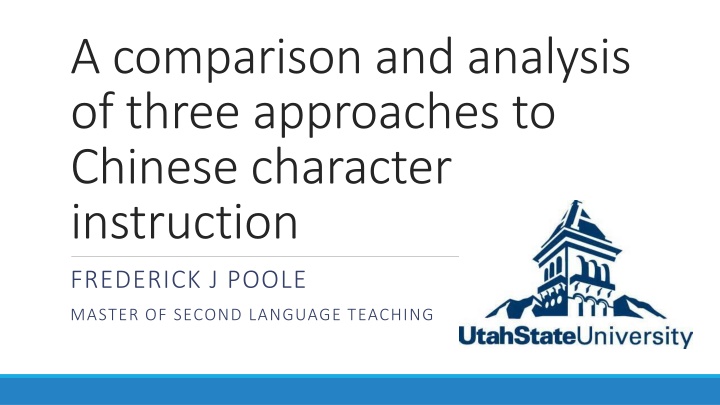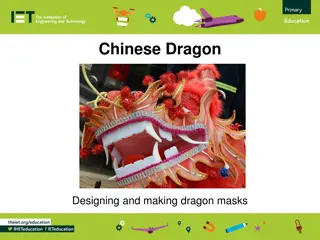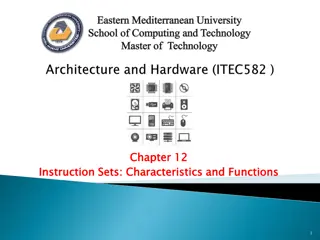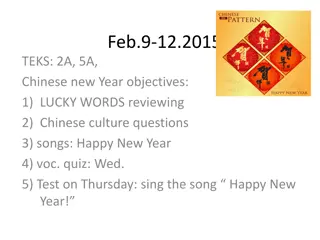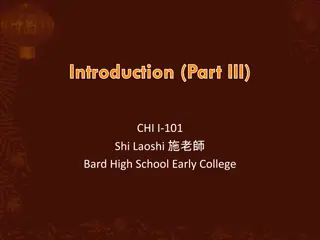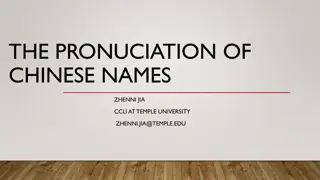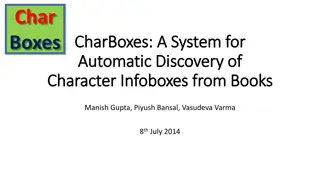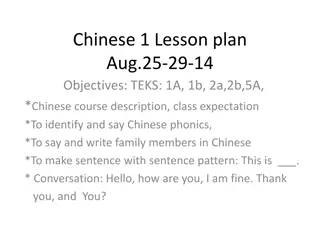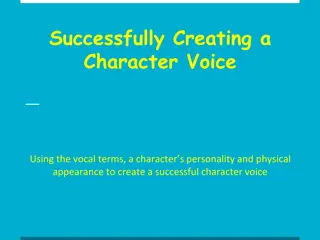Approaches to Chinese Character Instruction Analysis
This comparative analysis explores three instructional approaches to Chinese character learning: focus on Pinyin, focus on Writing, and focus on Recognition. The discussion delves into the benefits and drawbacks of each approach, shedding light on the challenges related to character recognition, stroke order, radical knowledge, and more. By examining the rationale behind different teaching methods, the study aims to provide insights into effective strategies for teaching Chinese characters.
Download Presentation

Please find below an Image/Link to download the presentation.
The content on the website is provided AS IS for your information and personal use only. It may not be sold, licensed, or shared on other websites without obtaining consent from the author.If you encounter any issues during the download, it is possible that the publisher has removed the file from their server.
You are allowed to download the files provided on this website for personal or commercial use, subject to the condition that they are used lawfully. All files are the property of their respective owners.
The content on the website is provided AS IS for your information and personal use only. It may not be sold, licensed, or shared on other websites without obtaining consent from the author.
E N D
Presentation Transcript
A comparison and analysis of three approaches to Chinese character instruction FREDERICK J POOLE MASTER OF SECOND LANGUAGE TEACHING
How much should we focus on characters in a beginning Chinese class? If too much, other skills get left behind If not enough, characters recognition suffers
What does it mean to learn a character? Orthographic Awareness vs. Strokes and Stroke Order
What does it mean to learn a character? Types of characters Phonetic Compound Ideogram Pictogram
What does it mean to learn a character? Radical Knowledge (Function and Location)
Why are characters hard to learn? Reproducing characters from memory is cognitively demanding Radicals only provide clues The clues are not always reliable
Three instructional approaches Focus on Pinyin Focus on Writing Focus on Recognition
Focus on Pinyin Arguments for: In our L1 we learn to speak before we learn to read Development of vocabulary is faster in a similar script Development of oral skills will facilitate reading Arguments Against: Students become too reliant on Pinyin Re-learning characters is frustrating Students lose interest in characters
Focus on Writing Arguments for: Breaks down complicated characters Motor-memory helps long term retention Able to lend more attention to radicals Arguments Against: Time consuming Studies show that learners can recognize characters without ever writing them.
Focus on Recognition Arguments for: Handwriting is not useful Word Processing more important More time efficient Arguments Against: Students do not learn proper stroke order Long-term retention of characters
Research Question How do Focus on Pinyin, Focus on Writing, and Focus on Recognition instruction effect the development of oral and character recognition skills? What are teacher and student perceptions of Focus on Pinyin, Focus on Writing, and Focus on Recognition instruction?
Research Methods Three instructional methods (FoP, FoW, and FoR) Nine Participants Each group was given 4-30minute sessions Students learned a total of 50 words Character recognition test and an oral assessment. Both teachers and students filled out surveys regarding their perceptions of the instructional methods Teachers: Students in a TCFL course
Focus on Pinyin Group Speaking and listening Lots of Repetition Focus on pronunciation Characters and pinyin presented on both PPT and handout Activities used pinyin
Focus on Writing Group Taught stroke order for all characters Taught radicals for all characters If there was time, completed oral tasks Characters and pinyin on PPT, but only characters on the handout
Focus on Recognition Character recognition exercises after each activity Pointed out important radicals, but this was not main focus Focus on speaking activities Characters and pinyin on the PPT, only characters on the handout
Assessment Oral Assessment Score Fluency 1 3 or more pauses in an answer Word Choice Repeats same vocabulary in each answer and no use of adverb Grammar 3 or more grammar mistakes Pronunciation 3 or more words are not comprehensible Comprehension Translation is incorrect or participant indicates that the question was not understood 1 to 2 pauses in answer Occasionally repeats vocabulary, only uses one adverb 1 to 2 grammar mistakes 1 to 2 words are not comprehensible Translation is partially correct 2 No pauses in answer Uses novel words and or adverbs No mistakes All words are clear and comprehensible Translation is correct 3 Character recognition Quiz
Results: Oral Assessment Group Fluency Word Choice Grammar Pronunciation Comprehension FoP 32.33 (89.8%) 33.66 (93.5%) 32 (88.8%) 35 (97.2%) 24 (100%) FoW 20 (55.5%) 20 (55.5%) 21.33 (59.3%) 22.66 (62.9%) 20.33 (84.7%) FoR 32.33 (89.8%) 31.33 (87%) 33.33 (92.6%) 35 (97.2%) 21.33 (88.8%)
Results: Character Recognition Group Quiz 1 Quiz 2 Quiz 3 Final Comp. Quiz FoP 11 (55%) 1.66 (16.6%) 1.33 (13.3%) 9 (18%) FoW 8.33 (41.7%) 6 (60%) 6 (60%) 30.66 (61.3%) FoR 12 (60%) 8.33 (83.3%) 6.33 (63.3%) 24 (48%)
Conclusion Focus on Recognition is more efficient Writing can still be useful (Homework)
Limitations Time Participant numbers Oral assessment rubric
